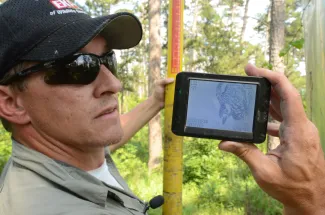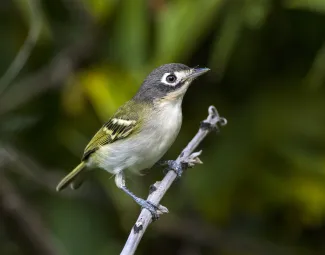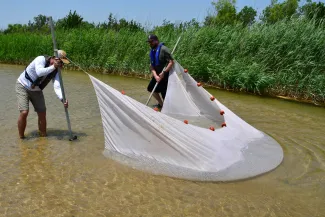The Endangered Species Act, the nation’s foremost law aimed at keeping plants and animals from becoming extinct, turns 50 on Dec. 28. This anniversary celebrates decades of targeted conservation efforts and dedicated partnerships and showcases the importance of future work.

The Wildlife Department has partnered with the U.S. Fish and Wildlife Service and the U.S. Forest Service to conserve federally endangered red-cockaded woodpeckers on the McCurtain County Wilderness Area. In addition to habitat management, biologists monitor the birds’ nesting success throughout the spring. Here, a biologist holds a camera on a long pole to look in the woodpecker’s nests and sees an adult incubating eggs.
A Continued Legacy
Created to protect and recover imperiled species, the ESA builds on the legacy of other conservation-minded legislation. The first U.S. wildlife law, the Lacey Act of 1900, was motivated by the looming extinction of the passenger pigeon and initially protected wild birds from poaching. The Migratory Bird Treaty Act, passed in 1918, further protected birds migrating between the U.S. and Canada. And the Endangered Species Protection Act of 1966 created the very first list of threatened and endangered species.
Among other things, the Endangered Species Act of 1973 more clearly defined threatened and endangered species – endangered species are in danger of extinction while threatened species are likely to become endangered within the foreseeable future – and allowed plants and invertebrates to be included in the list.
Today’s list of threatened and endangered plants and animals includes more than 1,650 species and distinct population segments. Twenty-three of those species, less than 1.5% of the total, can be found in Oklahoma. Two of the state’s federally listed species, the Indiana bat and the whooping crane, have the longest history with the ESA and were included in the original list of 77 protected species. And five species found in Oklahoma, the American alligator, American peregrine falcon, bald eagle, black-capped vireo, and interior least tern, have been deemed “fully recovered” and removed from the list.
The Black-capped Vireo: An Endangered Species Act Success Story
The small, migratory black-capped vireo is a great case study for the importance of targeted conservation work and partnerships. With habitat and species management, the songbird recovered from a low of 350 individuals in 1987.

A male black-capped vireo.
Before: A changing plant community, shifting from open scrubby habitat to more heavily wooded areas, and brood parasitism by native brown-headed cowbirds are thought to have been the leading causes of the black-capped vireo’s decline in its northern range. By the time the species was listed as endangered, only 350 of the migratory songbirds were known to exist. As few as 35 birds occurred in Oklahoma’s two strongholds, the Wichita Mountains Wildlife Refuge and adjacent Fort Sill military installation.
After: In the decades following the vireo’s listing, conservation agencies and land managers leaned on prescribed fire and brown-headed cowbird removal to reverse the bird’s decline. Fire can improve the vireo’s breeding habitat by thinning the overall tree canopy and promoting the preferred nesting structures. And removing cowbirds from the landscape can reduce the number of young vireos that are displaced by the larger cowbird chicks. With these conservation measures and others, the vireo’s population grew to an estimated 14,000 birds, which triggered its delisting in 2018. The number of vireos at Oklahoma’s two strongholds also grew to include more than 4,000 males. The U.S. Fish and Wildlife has continued to monitor the bird, with recent surveys indicated there are now more than 22,000 black-capped vireos found in the wild.
The Power of Partners
In addition to providing federal protections to listed species, the ESA encourages states to develop and maintain conservation programs to better safeguard the nation’s heritage in fish, wildlife, and plants. In Oklahoma, the Wildlife Department partners with the U.S. Fish and Wildlife Service to fund surveys and management projects to conserve and monitor the status of the state’s threatened, endangered, and ESA-candidate species.

The Oklahoma Department of Wildlife Conservation assists with annual surveys for federally listed species like the Arkansas River shiner. Here, biologists pull a long seine to sample fish at multiple sites along the Canadian River.
More than 125 Oklahoma-based projects have been funded by provisions of the ESA’s Cooperative Endangered Species Fund, with the state’s first project focusing on the now delisted black-capped vireo. These “Section 6” projects, and those funded by other conservation grant programs, have not only helped conservation agencies learn more about the needs and status of listed species, but also provide important data for listing decisions.
The Wildlife Department has shared data for species recently proposed for federal listing, including the alligator snapping turtle, tricolored bat, and pyramid pigtoe mussel.
Data are being shared on Oklahoma’s known populations of other petitioned species, including the Kiamichi crayfish, regal fritillary, little brown bat, southern plains bumble bee, Arogos skipper, and peppered shiner.
The USFWS used data on the Ozark emerald, Oklahoma salamander, Arkansas darter, plains spotted skunk, and seaside alder provided by ODWC to decide listings for these species weren’t warranted.
How well do you know Oklahoma's most vulnerable species? Take our free Threatened and Endangered Species Kahoot! quiz to test your knowledge.